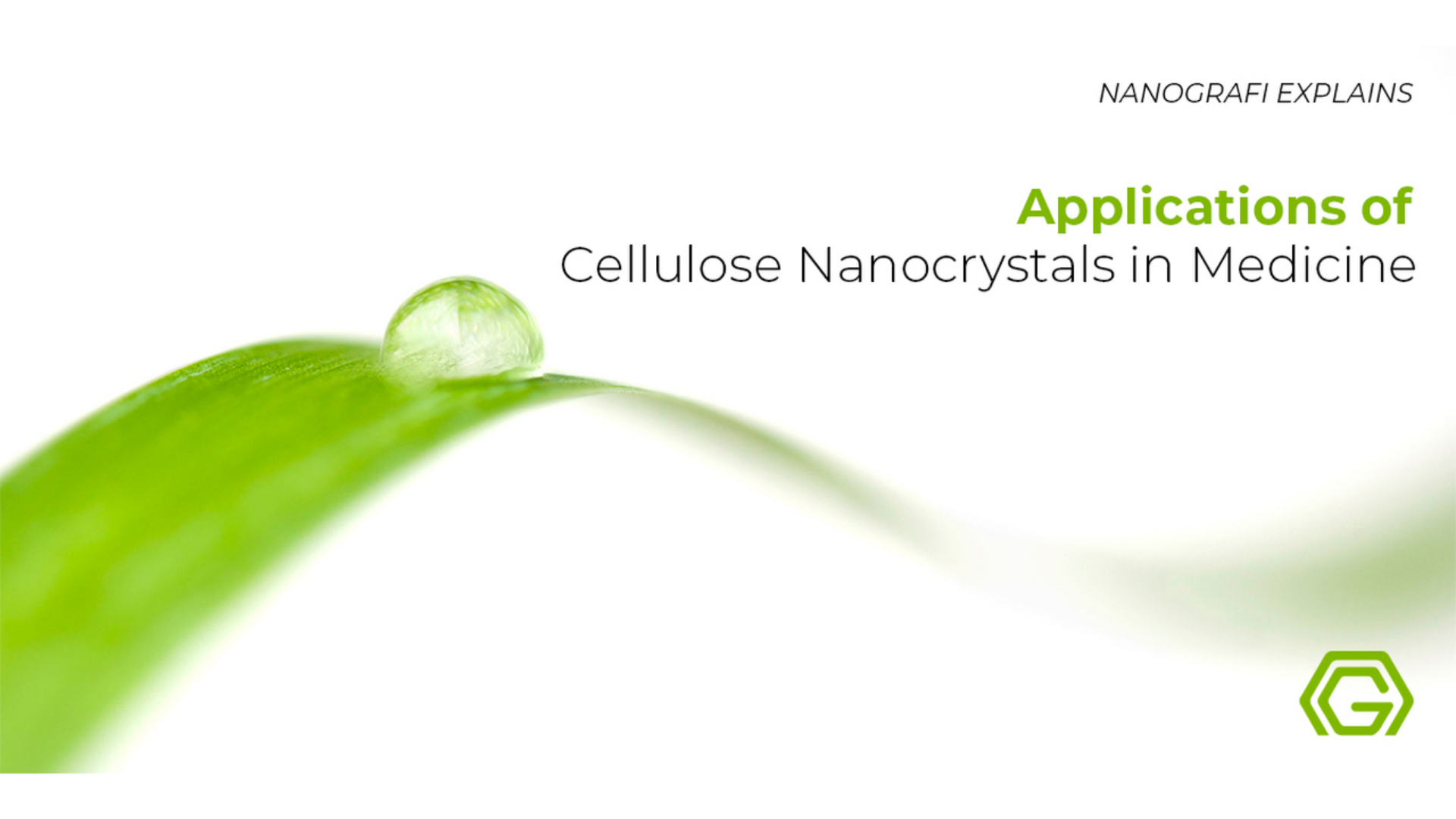Cellulose Suspension Applications
In the 21st century, when humans become aware of environmental conservation, applications of renewable resources become more and more important for their daily life since they are friendly to nature.
Nanotechnology, in the recent years, has gotten huge interest in many industries and nanotechnology has opened up for many new possibilities, such as in the forest industry and cellulose-based products.
Introduction
Nanotechnology is defined as the understanding and control of matter with at least one-dimension measuring from 1 to 100 nm.
Cellulose (Latin: rich in small cells) is a biopolymer found naturally in, for example, plant cells such as wood and cotton. It is the most abundant polymer in nature and is the main constituent in the cell wall of trees and plants. Cotton have the highest cellulose content of the plants with about 90% cellulose, compared to wood that has about 40–50% cellulose content or bast fibers, such as flax, hemp, or ramie, which have about 70–80% cellulose content. Besides wood and plants, cellulose can also be found in various bacterial species, algae, and tunicates, a sea animal that consists of proteins and carbohydrates.
Cellulose has been known for about 150 years and is a renewable and biodegradable polymer and has for a long time been used as energy source, building material, and clothing. By chemical modification on the cellulose polymers, cellulose derivatives such as cellulose ethers and cellulose ester can be prepared, which have opened up for many novel material and applications for cellulose such as coatings, films, membranes, new building materials, drilling techniques, pharmaceuticals, and food products. Also, the regeneration process of cellulose has contributed to novel techniques such as spinning of fibers and the viscose process.
Cellulose is a β (1-4)-linked chain of glucose molecules, accounting for around 50% of the carbon content in the lignocellulosic biomass. Therefore, this macromolecule, as a sustainable and renewable source, has garnered significant interest and encouraged researchers to develop cellulose-based materials with novel functions. Nanomaterials derived from cellulose are referred to as nanocellulose. Nanocellulose can be mainly categorized into nanocrystalline cellulose (NCC), nano-fibrillated cellulose (NFC), and bacterial nanocellulose (BNC). These types of nanocellulose, although very similar in composition, could present some differences in morphology, particle size or crystallinity, due to the different sources and extraction methods.
Nanocellulose
Nanocellulose is a natural nanomaterial which can be extracted from plant cell wall. With its nanometer size in diameter, nanocellulose consists of attractive properties such as high strength, excellent stiffness, and high surface area. In addition, with its structure, nanocellulose contains a plentiful of hydroxyl groups which are accessible for surface modification. The special attention is the size of nanocellulose fiber which generally contains less than 100 nm in diameter and several micrometers in length. Nanocellulose is a biodegradable nanofiber with light weight, low density (around 1.6 g/cm3) and outstanding strength property. Especially, it has high stiffness up to 220 GPa of elastic modulus which is greater than Kevlar fiber. Moreover, nanocellulose has high tensile strength up to 10 GPa which is greater than cast iron and its ratio of strength to weight is 8 times higher than stainless steel. In addition, nanocellulose is transparent and full of the reactive surface of hydroxyl groups which can be functionalized to various surface properties. By mechanical treatments or chemical modifications on cellulose pulp, nanometer-sized cellulose such as cellulose nanofibrils (CNFs) and cellulose nanocrystals (CNCs) can be produced. Nanocellulose has shown extraordinary properties compared with the bulk material but also with other materials such as Kevlar, carbon fibers, or stainless steel. Nanocellulose can be used in various fields in our life, such as biomedical products, nanocomposite materials, textiles, and so on. Nowadays, nanocellulose gets high attraction from research and industries. The study of nanocellulose is not only about its extraction from biomass, but also the new applications in various fields.
Nanocellulose can be categorized into three main types; nanocrystalline cellulose, nano-fibrillated cellulose, and bacterial nanocellulose ones. Although all types are similar in chemical composition, they are different in morphology, particle size, crystallinity, and some properties due to the difference of sources and extraction methods.
Lignocellulosic Biomass
Lignocellulosic biomass includes various natural organic matters which mostly refer to the plants or plant-based materials, which is the largest amount of sustainable carbon material group and the most promising feedstock for the sustainable production of biochemical, bioethanol, and biofuels. Especially, lignocellulosic biomass is a source of natural fiber which can substitute the petroleum-based polymers due to its outstanding environmentally friendly properties. Furthermore, the wastes from biomass such as agricultural wastes and forest residues have high potential for reuse as fuel or feedstock for production of high value-added materials without the competition with human and animal food chains.
To get more information about applications of cellulose,
you can read our blog post here.
Extraction of Nanocellulose from Lignocellulosic Biomass
Due to the outstanding properties of nanocellulose and possibility for the future applications, the study of nanocellulose extraction from lignocellulosic biomass is very attractive, especially for the extraction from agricultural residues. Figure 3 shows the schematic of nanocellulose extraction from lignocellulosic biomass which consists of two main steps. Firstly, the non-cellulosic components, such as lignin, hemicellulose, and other compounds, are removed by the pretreatment. Then, nanocellulose is extracted from cellulose fibrils by various extraction methods. The main extraction methods are categorized to three techniques: acid hydrolysis, enzymatic hydrolysis and mechanical process.
Applications of Cellulose Nanocrystal
CNC is a suitable nanomaterial for a wide range of applications, such as enzyme immobilization, synthesis of antimicrobial and medical materials, green catalysis, biosensing, synthesis of drug carrier in therapeutic and diagnostic medicine, etc. These nanomaterials offer several potential advantages as drug delivery excipients due to their properties such as smaller size, hydrophilicity, biocompatibility, etc. Due to their very large surface area and possibility of acquiring negative charge during hydrolysis, large quantities of drugs can be bound to the surface of these materials with the potential for optimal control of dosing.
Bio-composites
By using nanomaterials as fillers in composite materials improved stiffness, strength, toughness, barrier properties, and flame retardancy can be achieved compared to the pure polymer material. The addition of only a few percent (1–5 wt%) of nanomaterial is enough for these improvements due to the large surface area of the nanoparticles.
Compared to carbon nanotubes, which is the strongest nanofiber produced today, cellulose nanofibers from wood only have 25% of the strength but the costs for cellulose nanofibers are much lower than the costs for carbon nanotubes, which makes the wood-based nanomaterial more attractive for certain applications. The reinforcing ability of the cellulose whiskers comes from its high surface area and good mechanical properties.
There is a huge interest in nanocomposites from biobased resources in many different industries today due to the many benefits with nanocellulose compared to other conventional filler materials. Some industries interested in nanocomposites from cellulose-based materials are the automotive, aerospace, medical and health, packaging and forest industries.
Health and Safety Aspects of Cellulose
The cellulose material itself is classified as non-toxic and approved to be used in food products such as in thickening agents. Also, for nanocellulose, the health and safety aspects are approved but since nanoparticles are quite new in the health and safety area, other tests might be necessary for further understanding the nanoparticle material.
Conclusion
In conclusion, nanocellulose, in its different forms, shows increasing interest in the industry and society due to its many beneficial properties such as being environmentally friendly, its low cost, and high mechanical performance, there is a bright future for these types of materials. Also, other biobased nanomaterials, such as chitin or starch, will play an important role in the nano area future.
To summarize, nanocellulose is unique among a range of other nanostructured materials due to its benefits such as being a renewable, sustainable, nontoxic, and biocompatible nanomaterial. Due to its nanometric dimensions, large aspect ratio, and excellent mechanical and chemical properties, cellulose nanocrystal (CNC) has many potential applications in many areas, including materials science, electronics, and medicine. The emerging industrial extraction processes to obtain CNC in large quantities need to be optimized to achieve greater yield and quality. So far, most of the research has focused on characterizing the morphological, mechanical, optical, and liquid crystalline properties of CNC, but exploring various surface modification processes to manipulate the functionality of CNC without affecting its inherent properties will be the main focus of future research. This approach will make CNC attractive for use in a wide range of industrial applications, such as high-performance biodegradable material science, electronics, biomedical engineering, drug delivery, catalysis, etc. Innovations in this area may lead to versatile nanomaterials with improved properties. In polymer nanocomposite systems, attaining uniform dispersion and distribution of CNC in a polymer matrix is still a challenging issue, as aggregation or agglomeration is commonly encountered. A tailor-made chemical modification process is necessary to incorporate CNC into different polymer matrix systems effectively. Innovations in nanotechnology related to renewable nanomaterials such as CNC are anticipated to provide technologically advanced products that are not harmful to the environment.
To get more information, you can visit Blografi.
References
1.A. Dufresne, Nanocellulose: a new ageless bionanomaterial, Mater. Today 16 (2013) 220–227.
2.A. Dufresne, Nanocellulose: potential reinforcement in composites, Nat. Polym., Vol. 2: Nanocompos. 2 (2012) 1–32.
3.H.V. Lee, S.B.A. Hamid, S.K. Zain, Conversion of lignocellulosic biomass to nanocellulose: structure and chemical process, Sci. World J. 2014 (2014) 1–20.
4.Giri, J., & Adhikari, R. (2012). A Brief review on extraction of nanocellulose and its application. Bibechana, 9, 81-87. doi:10.3126/bibechana.v9i0.7179
5.Börjesson, M., & Westman, G. (2015). Crystalline Nanocellulose — Preparation, Modification, and Properties. Cellulose - Fundamental Aspects and Current Trends. doi:10.5772/61899
6.Moberg, T., Sahlin, K., Yao, K., Geng, S., Westman, G., Zhou, Q., . . . Rigdahl, M. (2017). Rheological properties of nanocellulose suspensions: Effects of fibril/particle dimensions and surface characteristics. Cellulose, 24(6), 2499-2510. doi:10.1007/s10570-017-1283-0
7.Klemm D, Heublein B, Fink HP, Bohn A. Cellulose: fascinating biopolymer and sustainable raw material. Angew Chem Int Ed. 2005;44:3358–3393.
8.Habibi Y, Lucia LA, Rojas OJ. Cellulose nanocrystals: chemistry, selfassembly, and applications. Chem Rev. 2010;110:3479–3500.
9.Sjostrom E. Wood Chemistry: Fundamentals and Applications. 2nd ed. California: Academic Press Inc; 1993.
Recent Posts
-
Reducing the Carbon Footprint of Nanomaterials
The production of nanomaterials is vital for numerous advanced applications, from healthcare to elec …26th Apr 2024 -
Nanocomposites in Food Packaging
The utilization of nanocomposites in food packaging represents a significant advancement in the fiel …19th Apr 2024 -
What is the Difference Between 7075 and 6061 Aluminum Alloy?
When comparing 7075 aluminum alloy to 6061 aluminum alloy, it's essential to understand their disti …5th Apr 2024







